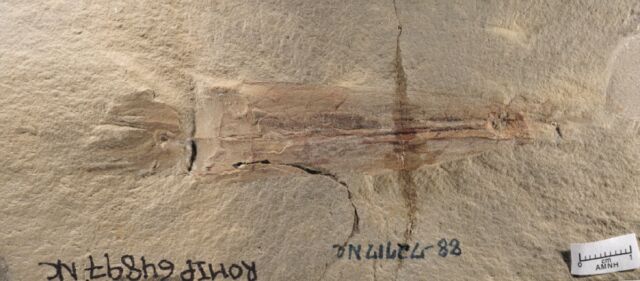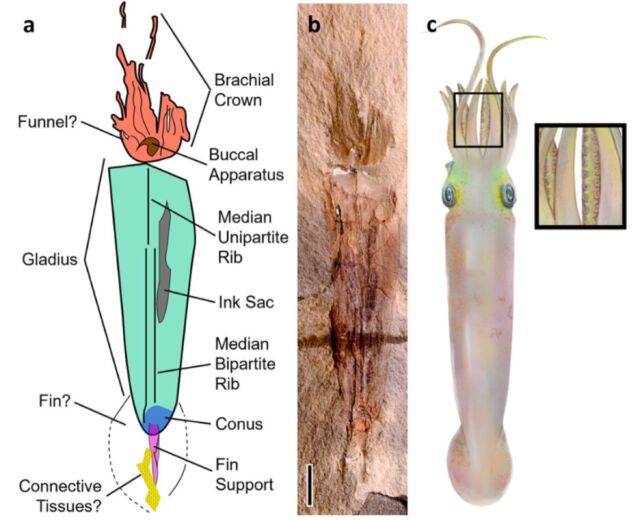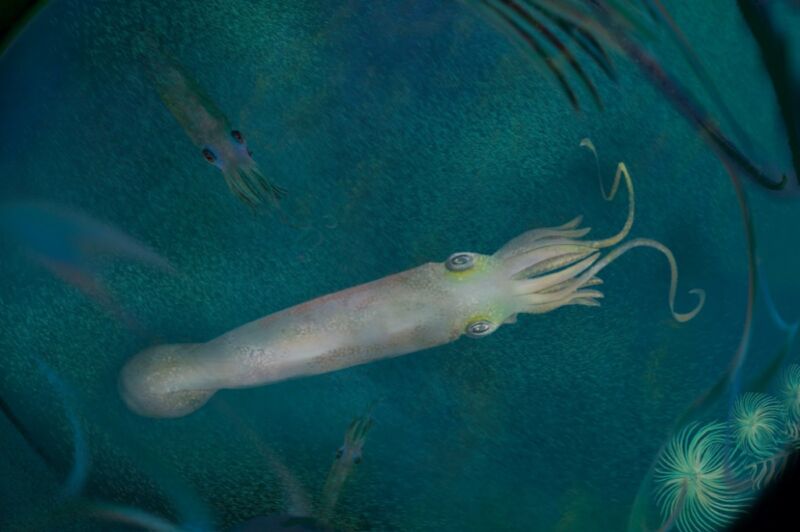Paleontologists believe they have discovered a new genus and species of extinct cephalopod with ten functional arms, similar to a vampire squid. The 328-million-year-old fossil is the earliest known example of a vampyropod (ancient soft-bodied cephalopods) to date, pushing back the earliest evidence by 82 million years, according to a new paper published in the journal Nature Communications. Other paleontologists aren't so sure, believing the specimen might represent a different known species of ancient cephalopods and calling for a full chemical analysis to confirm the species one way or the other.
The fossil was excavated from Bear Gulch Limestone in Montana. The fossils found there tend to be exceptionally well-preserved—sometimes even showing vascularization—thanks to the impact of seasonal monsoons. That heavy rainfall rapidly deposited sediments and other biological matter into the bay, in turn feeding algal blooms. Those algal blooms resulted in temporary oxygen-deprived zones, while the sudden infusion of fresh water from the rain would have lowered saline levels, according to the authors.
The fossil was donated to the Royal Ontario Museum in 1988, and there it sat, unnoticed for decades, until co-author Christopher Whalen, a postdoc in paleontology at the American Museum of Natural History in New York City, was perusing the collection and spotted the arms. When he looked at the specimen more closely under the microscope, he noticed small suckers on those arms, making this an incredibly rare find, since suckers are typically not preserved.

Further visual examination showed that the fossil had ten arms, like modern squids and cuttlefish. Octopuses have eight arms, while vampire squids (closely related to octopuses) have eight arms and two thin filaments believed to have once have been an additional two arms.
"The arm count is one of the defining characteristics separating the ten-armed squid and cuttlefish line (Decabrachia) from the eight armed octopus and vampire squid line (Vampyropoda)," said Whelan. "We have long understood that octopuses achieve the eight-arm count through elimination of the two filaments of vampire squid and that these filaments are vestigial arms. However, all previously reported fossil vampyropods preserving the appendages only have eight arms, so this fossil is arguably the first confirmation of the idea that all cephalopods ancestrally possessed ten arms.”
Two of the specimen's ten arms seem to be elongated compared to the other eight, but they are not any thinner and hence are unlike the vestigial filaments found in other species. Since the arms are not completely preserved, the authors acknowledge that the elongation might just be an artifact; more fossil specimens are needed to confirm this. However, they consider this possibility unlikely since both elongated arms are roughly the same length. The best preserved of the shorter arms are also roughly the same length.
S. bideni likely had a body shaped like a torpedo, with fins to help propel itself through the water. Surprisingly, there was no evidence of a rostrum, which acted as a counterweight so early cephalopods could swim horizontally

“Syllipsimopodi may have filled a niche more similar to extant squids, a midlevel aquatic predator,” said co-author Neil Landman, the museum's curator emeritus. “It is not inconceivable that it might have used its sucker-laden arms to pry small ammonoids out of their shells or ventured more inshore to prey on brachiopods, bivalves, or other shelled marine animals.”
Not everyone is convinced this fossil represents a new species, however. University of Zurich paleontologist Christian Klug told the New York Times that he thinks it might be a specimen of another known species of ancient cephalopods, Gordoniconus beargulchensis. "It's the exact same size, the exact same age, the exact same locality, the exact same proportions, and it's just preserved a little bit differently," he said, adding that a chemical analysis (while expensive) would help resolve the issue.
Whalen, of course, stands by his identification, pointing out that most cephalopods have a chambered shell called a phragocone, which helps control buoyancy. It features distinctive mineralized sheets dividing the chambers, which are usually evident in fossilized cephalopods. S. bideni shows no sign of those sheets. Instead, it shows evidence of a gladius, a flattened remnant of what was once an internal shell. "Today, only squids and their relatives, and vampire squid, have a gladius," Whalen said. "Octopods have reduced it to a fin support or stylets, which are small, hard, bar-shaped structures."
DOI: Nature Communications, 2022. 10.1038/s41467-022-28333-5 (About DOIs).



3175x175(CURRENT).thumb.jpg.b05acc060982b36f5891ba728e6d953c.jpg)

Recommended Comments
There are no comments to display.
Join the conversation
You can post now and register later. If you have an account, sign in now to post with your account.
Note: Your post will require moderator approval before it will be visible.